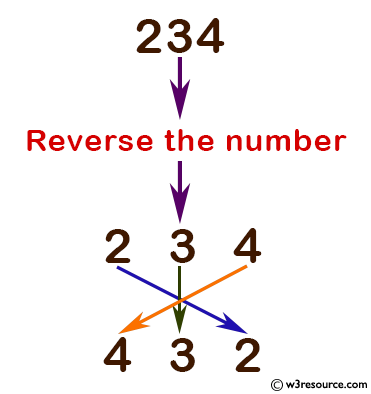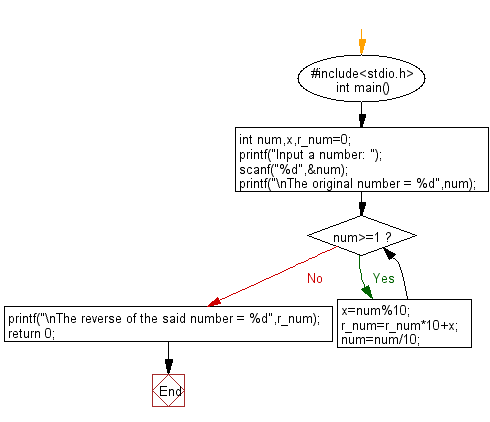C Exercises: Reverse and print a given number
C Basic Declarations and Expressions: Exercise-57 with Solution
Write a C program to reverse and print a given number.
Pictorial Presentation:

Sample Solution:
C Code:
#include<stdio.h>
int main()
{
int num,x,r_num=0;
printf("Input a number: ");
scanf("%d",&num);
printf("\nThe original number = %d",num);
while(num>=1)
{
x=num%10;
r_num=r_num*10+x;
num=num/10;
}
printf("\nThe reverse of the said number = %d",r_num);
return 0;
}
Sample Output:
Input a number: The original number = 234 The reverse of the said number = 432
Flowchart:

C programming Code Editor:
Contribute your code and comments through Disqus.
Previous: Write a C program to shift given data by two bits to the left.
Next: Write a C program that accepts 4 real numbers from the keyboard and print out the difference of the maximum and minimum values of these four numbers.
What is the difficulty level of this exercise?
Test your Programming skills with w3resource's quiz.
C Programming: Tips of the Day
Static variable inside of a function in C
The scope of variable is where the variable name can be seen. Here, x is visible only inside function foo().
The lifetime of a variable is the period over which it exists. If x were defined without the keyword static, the lifetime would be from the entry into foo() to the return from foo(); so it would be re-initialized to 5 on every call.
The keyword static acts to extend the lifetime of a variable to the lifetime of the programme; e.g. initialization occurs once and once only and then the variable retains its value - whatever it has come to be - over all future calls to foo().
Ref : https://bit.ly/3fOq7XP
- New Content published on w3resource:
- HTML-CSS Practical: Exercises, Practice, Solution
- Java Regular Expression: Exercises, Practice, Solution
- Scala Programming Exercises, Practice, Solution
- Python Itertools exercises
- Python Numpy exercises
- Python GeoPy Package exercises
- Python Pandas exercises
- Python nltk exercises
- Python BeautifulSoup exercises
- Form Template
- Composer - PHP Package Manager
- PHPUnit - PHP Testing
- Laravel - PHP Framework
- Angular - JavaScript Framework
- Vue - JavaScript Framework
- Jest - JavaScript Testing Framework
